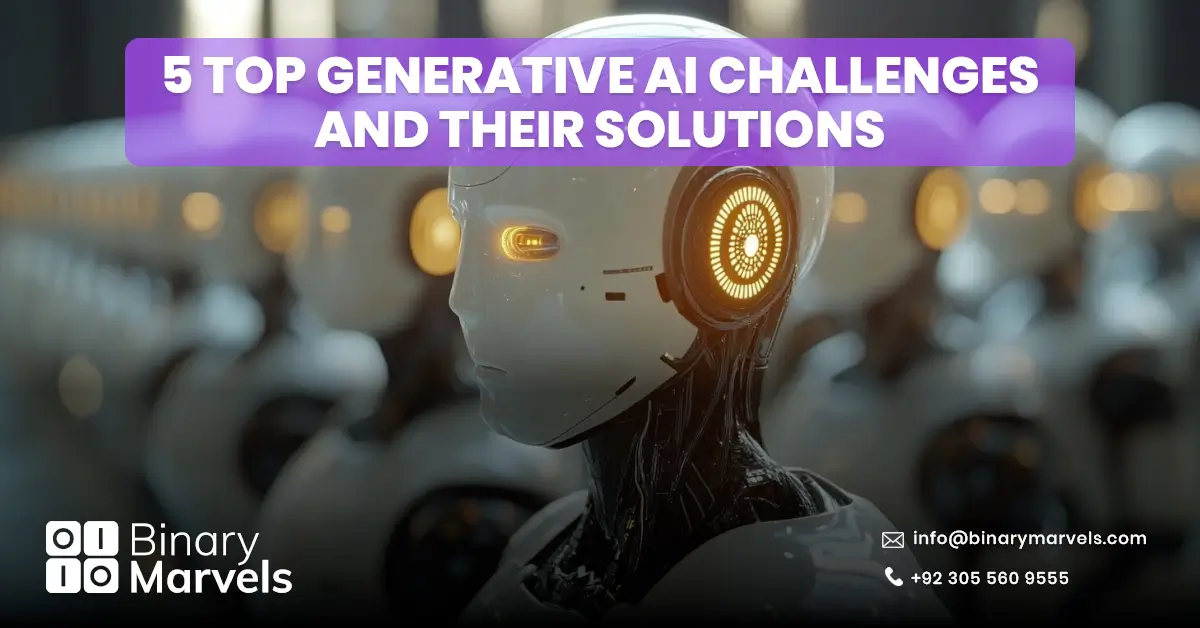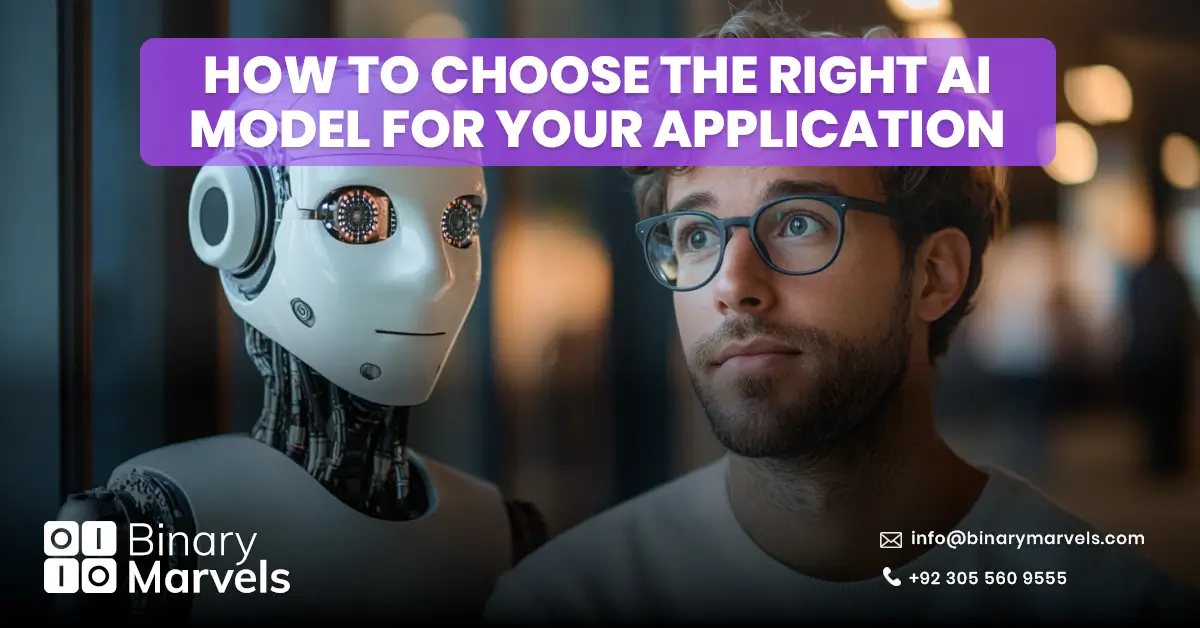
Generative AI is revolutionizing numerous industries, from content creation to data analysis and healthcare. It refers to AI systems that can generate new data, such as text, images, videos, and even audio, by learning from vast datasets. With the increasing capabilities of generative AI models, businesses are exploring new ways to enhance their operations, marketing efforts, and customer experiences.
However, as businesses and developers integrate generative AI into their processes, they face several key challenges. These challenges range from data-related issues to ethical dilemmas, technical complexities, and the sheer scale of resources required. In this article, we will explore the top 5 generative AI challenges and provide effective solutions to help businesses navigate and mitigate these issues for successful AI implementation.
At Binary Marvels, we understand the importance of adopting generative AI to boost business growth. Our expertise in AI implementation helps you tackle these challenges head-on, ensuring your AI solutions are efficient and effective.
Also Read: Top 10 AI Companies in Pakistan
5 Top Generative AI Challenges and their Solutions
1. Data Bias in Generative AI Models
Challenge:
Data bias is one of the most significant and well-documented challenges in the realm of generative AI. AI models are trained on massive datasets that are often derived from existing human-created content, which can carry inherent biases. These biases are then perpetuated by AI systems in their outputs, leading to harmful or unfair results. For example, a generative AI system trained on biased language data may produce discriminatory text, leading to unintended harm when deployed in real-world applications.
Example:
An AI model used for recruiting may be trained on historical data that underrepresents certain demographic groups, leading to biased hiring decisions that favor certain races, genders, or ethnicities. Similarly, AI in healthcare could generate biased treatment plans that fail to serve all patient demographics equally.
Solution:
Diverse and Inclusive Data: To tackle data bias, it is essential to ensure that the data used to train generative AI models is diverse and representative of different groups, cultures, and perspectives. This includes incorporating data from diverse sources, ensuring that no group is disproportionately represented or left out.
Data Augmentation: Data augmentation techniques like paraphrasing or synthetic data generation can be used to artificially balance the dataset, providing additional examples from underrepresented groups to train more fair models.
Bias Auditing Tools: Using tools like AI Fairness 360 from IBM or Fairness Flow from Google helps developers evaluate and mitigate bias in their models. Regular auditing of AI systems, especially before deployment, ensures the outputs align with fairness standards.
Key Action:
Regular audits of datasets and models should be carried out to identify and correct biases, ensuring that generative AI models produce outputs that are fair and representative of diverse populations.
2. Scalability of Generative AI Models
Challenge:
As AI models grow more complex, their scalability becomes an issue. The computational requirements for training state-of-the-art generative AI models, such as GPT-3, are immense. These models require substantial computational power, translating into high costs for businesses looking to scale their AI projects. This can be a barrier, especially for small businesses or startups that cannot afford the required hardware and infrastructure.
Example:
Generative models such as GPT-3 have billions of parameters, which require expensive computational resources, making it difficult for organizations to train and deploy these models efficiently at scale.
Solution:
Model Optimization Techniques: To make AI models more scalable, developers are employing model compression techniques, including pruning, quantization, and knowledge distillation. These techniques reduce the size of models while retaining their performance, allowing them to be deployed with fewer computational resources.
Distributed Computing and Cloud Solutions: By utilizing cloud services like Google AI Platform, Amazon SageMaker, and Microsoft Azure, businesses can leverage scalable infrastructure on demand. These platforms provide access to specialized AI hardware such as Tensor Processing Units (TPUs) and Graphics Processing Units (GPUs), which are optimized for large-scale AI training and inference.
Pre-trained Models: Another solution to scalability is using pre-trained models. Models like GPT-2 or BERT, which have already been trained on large datasets, can be fine-tuned for specific use cases, reducing the time and cost of training from scratch.
Key Action:
Adopt model compression and optimization techniques, leverage cloud-based AI infrastructure, and utilize pre-trained models to make AI systems more cost-effective and scalable.
3. Lack of Transparency and Explainability in AI Models
Challenge:
Generative AI models, especially deep learning-based models, are often described as “black boxes” because their decision-making processes are not easily understandable. This lack of transparency can be problematic in industries such as healthcare, finance, and law, where understanding how AI arrives at a particular conclusion is critical to trust and accountability.
Example:
In a medical diagnostic AI, if the AI generates a diagnosis without explaining how it reached that conclusion, it can lead to distrust among healthcare professionals and patients. A lack of transparency can prevent the AI system from being fully adopted, even if it has high accuracy.
Solution:
Explainable AI (XAI): One effective solution is to integrate Explainable AI (XAI) techniques. XAI aims to make AI models more transparent by providing insights into how the model processes input data and generates output. Tools like LIME (Local Interpretable Model-Agnostic Explanations) and SHAP (Shapley Additive Explanations) help break down complex model predictions into understandable explanations.
Human-in-the-Loop (HITL): Incorporating human oversight into the AI decision-making process ensures that the results generated by AI can be validated and understood. This is particularly crucial for high-stakes fields like healthcare, finance, and law, where human intervention is essential for the model’s outputs.
Key Action:
Integrate XAI techniques into the development process and include human oversight to improve the transparency and explainability of generative AI models.
4. High Energy Consumption and Environmental Impact
Challenge:
Training large-scale generative AI models requires vast computational power, leading to significant energy consumption and carbon emissions. This environmental impact is a growing concern, especially as the number of AI models and their complexity continues to increase. Companies face the challenge of balancing the benefits of cutting-edge AI with the need for environmental sustainability.
Example:
Training a model like GPT-3 can generate as much carbon as five cars over their entire lifetimes. The environmental costs of AI are substantial, especially when the models are deployed at scale in industries that require real-time predictions and outputs.
Solution:
Energy-Efficient Hardware: AI companies are turning to energy-efficient hardware such as Graphics Processing Units (GPUs) and Tensor Processing Units (TPUs), which are designed for high-performance deep learning and offer better energy efficiency compared to traditional hardware.
Renewable Energy-Powered Data Centers: Many tech giants are investing in green data centers that run on renewable energy, significantly reducing the carbon footprint of training and deploying AI models. Companies like Google and Microsoft have already committed to running their data centers entirely on renewable energy.
Key Action:
Adopt energy-efficient hardware, utilize cloud services that use renewable energy, and optimize training processes to reduce the overall environmental impact of AI development.
5. Ethical Concerns in AI-Generated Content
Challenge:
Generative AI has the potential to produce highly realistic content, including text, images, and video. While this technology is incredible, it also raises serious ethical concerns. AI-generated content, such as deepfakes, can be used to manipulate public opinion, spread misinformation, and violate intellectual property rights.
Example:
Deepfake videos have been used to create fake content that appears real, which has serious implications for politics and social media. The ability to create convincing fake videos of public figures can lead to widespread misinformation and distrust.
Solution:
Content Moderation Systems: Businesses can integrate AI-powered content moderation tools to detect and filter out harmful or misleading AI-generated content. These tools can identify deepfakes, misinformation, and inappropriate content, ensuring that only trustworthy and ethical content is disseminated.
Ethical AI Guidelines: Governments and organizations should establish clear ethical AI guidelines to ensure responsible AI usage. These guidelines should include frameworks for using generative AI in a way that aligns with societal values and ensures the technology serves the greater good.
Key Action:
Develop ethical guidelines for the use of generative AI, integrate content moderation systems to detect harmful content, and promote responsible AI practices across industries.
Why Choose Binary Marvels for AI Development Services?
At Binary Marvels, we deliver cutting-edge AI Development Services tailored to your business needs. As a top software house in Pakistan, we specialize in building ethical, scalable, and high-performance AI solutions.
- Expert Team: Skilled in generative AI, NLP, and computer vision.
- Ethical & Transparent: We follow best practices for fairness and explainability.
- Custom Solutions: Designed to fit your goals and industry requirements.
- Sustainable Approach: We focus on energy-efficient and eco-friendly AI development.
- Ongoing Support: Reliable maintenance to keep your AI systems optimized.
Partner with Binary Marvels to transform your business with trusted AI Development Services.
FAQs
What are the main challenges of generative AI?
The main challenges include data bias, scalability, lack of transparency, high energy consumption, and ethical concerns regarding AI-generated content.
How can businesses address AI scalability issues?
Businesses can address scalability by utilizing model optimization techniques and cloud-based AI platforms to provide the necessary computational resources.
What is explainable AI (XAI)?
Explainable AI refers to techniques that help make AI models more transparent by providing insights into how they work and why they make certain decisions.
Why is energy efficiency important in AI?
Energy efficiency reduces the environmental impact of AI, lowers operational costs, and makes AI models more sustainable in the long run.
Conclusion
Generative AI has the potential to revolutionize industries and improve various aspects of our lives. However, its growth is impeded by several challenges, including data bias, scalability, transparency, energy consumption, and ethical concerns. By addressing these challenges with innovative solutions, businesses can unlock the full potential of generative AI while minimizing its risks.
At Binary Marvels, we understand the importance of navigating the complexities of generative AI. As the Best Software House In Pakistan, we are committed to helping businesses harness AI’s power in a responsible and scalable way. By integrating cutting-edge solutions into your AI projects, you can stay ahead of the curve and drive meaningful innovation.
If you are looking for AI solutions that cater to your business needs, don’t hesitate to contact us at Binary Marvels. Our team of experts can guide you through the challenges and opportunities of generative AI.
Supercharge Your Business with AI Today!
As a trusted AI Development Company in Pakistan, we deliver cutting-edge AI Development Services designed to streamline your operations and enhance customer engagement.
Don’t wait—connect with us now and take your business to the next level!









